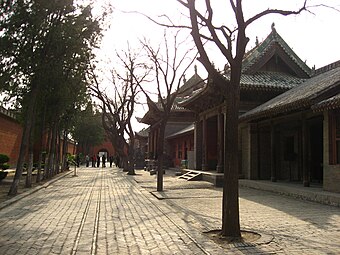| Haizhou Guandi Temple | |
|---|---|
 | |
| Religion | |
| Affiliation | Taoism |
| Location | |
| Location | Haizhou, Yuncheng, Shanxi |
| Country | China |
| Architecture | |
| Date established | 589 |
Haizhou Emperor Guan Temple (simplified Chinese: 解州关帝庙; traditional Chinese: 解州關帝廟), or Haizhou Guandi Temple, is a temple located in Haizhou Town, Yanhu District, Yuncheng City, Shanxi Province. It is hailed as "the grand ancestor of temples dedicated to Guan Yu" (关庙之祖). The Temple is the largest extant palace-style Taoist complex and martial temple in China.
Haizhou Emperor Guan Temple is the largest Emperor Guan Temple (关帝庙) in China. It has a total area of 220,000 square meters, with more than 200 rooms.
History
Haizhou Emperor Guan Temple was established in the ninth year of Kaihuang (开皇) during the Sui dynasty (589), expanded and rebuilt during the Song dynasty and Ming dynasty.
Haizhou Emperor Guan Temple was destroyed by fire in the forty-first year of Kangxi (1702) during the Qing dynasty and was restored after more than ten years.
Conservations
In 1957, Haizhou Emperor Guan Temple was designated by the Shanxi Provincial People's Government as the first batch of provincial-level key cultural relics protection units in Shanxi Province.
In 1988, Haizhou Emperor Guan Temple was listed as a Major Historical and Cultural Site Protected at the National Level in China.
Gallery
References
- "Eight boutique lines leisure tour of Shanxi". Xinhuanet.com. 2015-07-24.
- Hu Miaosen; Jiang Zhuping (2005). China Building Map. Bright Daily Press. pp. 98–. ISBN 978-7-80145-913-8.
- Stanley Henning (9 March 2018). Henning's Scholarly Works on Chinese Combative Traditions. Via Media Publishing. pp. 73–. ISBN 978-1-986369-24-4.
- "Haizhou Guandi Temple Cultural Resource Development of Cultural Industry Perspective". China National Knowledge Infrastructure. 2017-10-16. Archived from the original on 2021-03-13. Retrieved 2021-03-08.
- "Haizhou Emperor Guan Temple (photoes)". Sohu News. 2007-05-13.
- Michael DeMarco (17 August 2016). Bagua and Xingyi: An Intersection of the Straight and Curved. Via Media Publishing. pp. 128–. ISBN 978-1-893765-33-7.
- "National Day Long Vacation Shanxi waiting for you to come". Science Guide. 2019-09-24. Archived from the original on 2021-03-09. Retrieved 2021-03-08.
- "More than 40 stone monkeys "hide" in China's largest Emperor Guan Temple". Xinhuanet.com. Feb 25, 2016. Archived from the original on March 10, 2021. Retrieved March 8, 2021.
- "Aerial photography of Haizhou Guandi Temple in Shanxi". China News Service. 2016-09-26.
- "Shanxi promotes tourism in Northeast China". China Daily. 2015-06-25.
- "Haizhou Guandi Temple in Yuncheng". China News Service. 2007-05-26.
- "Haizhou Emperor Guan Temple". China National Knowledge Infrastructure. 2016-10-14. Archived from the original on 2021-03-10. Retrieved 2021-03-08.
- ""Guan Sheng Cultural Complex" heritage application materials will be submitted to the State Administration of Cultural Heritage". China News Service. 2014-03-27.
- "Shanxi Haizhou Emperor Guan Temple Scenic Area". Xinhuanet.com. 2018-05-11. Archived from the original on March 9, 2021.
This article related to the history of China is a stub. You can help Misplaced Pages by expanding it. |
This article about a Chinese religious building or structure is a stub. You can help Misplaced Pages by expanding it. |
- Guandi temples
- Taoist temples in China
- 6th-century establishments in China
- 6th-century religious buildings and structures
- Historic buildings and structures
- Major National Historical and Cultural Sites in Shanxi
- Buildings and structures in Yuncheng
- Tourist attractions in Yuncheng
- 589 establishments
- Chinese history stubs
- People's Republic of China religious building and structure stubs

